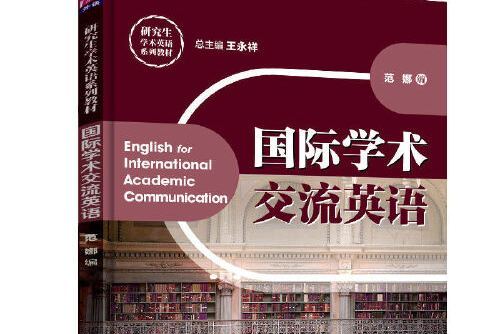內容簡介
本教材既可作為我國高校研究生和高年級本科生的學術英語教材,又可供有興趣提高學術英語交流能力的學生作為課後輔導教材使用。
本書共十四章,以參加國際學術會議為主線,涉及學術會議的信息來源、會議通信、論文提交、 經濟資助、會議主持、演講、討論、會議海報等相關內容。本書注重培養學生使用英語進行國際學術交流的能力,強調學以致用;突出選材的實用性,注重構建學術交流場景和營造語言套用環境;選材具有時代性、規範性、全面性、知識性和啟迪性,難易適中,便於學生獲取信息和提高國際學術交流能力。
圖書目錄
Obtaining Conference Information. 1
1.1 Different Meetings 2
1.1.1 Meeting .2
1.1.2 Conference .2
1.1.3 Symposium 2
1.1.4 Convention.3
1.1.5 Forum .3
1.1.6 Seminar .3
1.1.7 Workshop 3
1.1.8 Colloquium 3
1.2 Sources for Obtaining Conference Information 4
1.2.1 The Internet4
1.2.2 Membership of Professional Organizations .5
1.2.3 Professional Journals 7
Conference Notice and Call for Conference Papers . 9
2.1 Conference Notice 10
2.2 Call for Conference Papers .16
Conference Committees and Session Modes 25
3.1 Conference Committees 26
3.1.1 Planning Committee 26
3.1.2 Program Committee . 26
3.1.3 Registration Committee.27
3.1.4 Conference Arrangements Committee 27
3.1.5 Publications Committee. 27
3.1.6 Exhibits Committee 27
3.1.7 Local Arrangements Committee.27
3.2 Session Modes.28
3.2.1 Keynote Session 28
3.2.2 Oral Session 28
3.2.3 Poster Session 28
3.2.4 Research-in-Progress Session. 28
3.2.5 Discussion/Question and Answer Session 29
3.3
Session Format . 29
International Letter Exchanges 31
4.1
Format of a Formal Letter32
4.1.1 Letterhead.32
4.1.2 Date of Writing. 32
4.1.3 Inside Address 33
4.1.4 Salutation 33
4.1.5 Body of Writing34
4.1.6 Complimentary Close 37
4.1.7 Signature . 38
4.2 Letters of Invitation .39
4.3 Letters of Acceptance . 42
4.4
Effective E-Mails 44
Financial Assistance for Attending Conferences. 49
5.1
Possible Sources for Financial Support. 50
5.1.1 Membership and Studentship.50
5.1.2 Financial Assistance by the Conference . 50
5.1.3 Awards51
5.1.4 Financial Assistance by Learned Societies.51
5.1.5 Financial Assistance by International Organizations . 51
5.2 Techniques of Writing Letters Applying for Financial Aid .51
5.2.1 Direct Statement. 52
5.2.2 Flank Inquiry. 52
5.2.3 Citation of Others’ Information 52
5.2.4 Writing a Postscript 52
Chairing a Meeting 55
6.1 A Chairman’s General Duties 56
6.1.1 The Opening Ceremony . 56
6.1.2 The Closing Ceremony 56
6.1.3 A Plenary Session 57
6.1.4 A Presentation Session . 57
6.1.5 A Discussion Session . 57
6.2 Chairing an International Conference. 58
6.2.1 Chairing the Opening Ceremony 58
6.2.2 Chairing the Closing Ceremony 59
6.3 General Chairing Procedures .61
6.3.1 Opening a Meeting 61
6.3.2 Introducing a Speaker. 62
6.3.3 Organizing a Discussion Session. 63
6.3.4 Thanking the Speaker . 64
6.3.5 Adjourning or Closing the Meeting . 65
Preparing the Presentation. 69
7.1 What Is a Presentation?70
7.2 Characteristics of Spoken Language70
7.3 Writing a Presentation Script 71
7.3.1 A Clear Structure. 71
7.3.2 Simple Vocabulary and Sentence Structures 72
7.3.3 A Personal Style.73
7.3.4 Figures of Speech . 73
7.4 Preparations for a Presentation74
7.4.1 Reading the Academic Paper Aloud74
7.4.2 Writing the Presentation Script with Spoken Features . 74
7.4.3 Practicing the Presentation. 75
Beginning the Presentation 77
8.1 Catching Attention .78
8.1.1 Telling a Story.78
8.1.2 Asking a Question 79
8.1.3 Using Startling Statistics 79
8.1.4 Using Visual Aids. 80
8.1.5 Saying Something Humorous80
8.2 Revealing the Topic.81
8.2.1 Communicating the Topic.81
8.2.2 Emphasizing the Significance of the Topic 81
8.2.3 Providing Background Information . 81
8.2.4 Outlining the Main Points 81
8.3
Establishing Credibility.82
Developing the Presentation.85
9.1
Structure in Developing the Presentation 86
9.2 Organizational Patterns 88
9.2.1 Chronological Pattern.88
9.2.2 Description Pattern88
9.2.3 Comparison and Contrast Pattern89
9.2.4 Cause and Effect Pattern 89
9.3 Supporting Materials 89
9.3.1 Statistics . 90
9.3.2 Testimony 90
9.3.3 Explanation.90
9.3.4 Illustration. 90
9.3.5 Comparison and Contrast 91
Ending the Presentation 93
10.1 Signaling the End .94
10.2 Restating the Topic . 95
10.3
Ending the Presentation 95
Asking and Answering Questions 97
11.1
Handling Questions.98
11.1.1 Choosing Questioners . 98
11.1.2 Listening Carefully to the Question 98
11.1.3 Welcoming the Question99
11.1.4 Repeating or Paraphrasing the Question . 99
11.1.5 Replying Clearly, Briefly, and Positively 99
11.1.6 Referring Back to the Questioner 101
11.2 Raising Questions.101
11.2.1 Signaling Your Intention .102
11.2.2 Expressing Your Attitude 102
11.2.3 Asking a Specific Question.102
11.3
Rehearsing Questions and Answers103
Oral Presentation Skills105
12.1
Visual Aids 106
12.2 Verbal Use 106
12.2.1 Simplicity .107
12.2.2 Accuracy.107
12.2.3 Appropriateness107
12.2.4 Figures of Speech107
12.2.5 Humor .107
12.3 Non-Verbal Behavior 108
12.3.1 Eye Contact .108
12.3.2 Posture108
12.3.3 Movement .108
12.4
Stage Fright109
Poster Presentations111
13.1
Advantages and Disadvantages of Poster Presentations.112
13.1.1 Advantages of Poster Presentations 112
13.1.2 Disadvantages of Poster Presentations.113
13.2 Creating the Poster113
13.2.1 Poster Content .113
13.2.2 “Less Is More” Design 114
13.3
Presenting the Poster.117
Talking with Professionals119
14.1
Purposes of Talking.120
14.2 Starting a Talk 120
14.2.1 Talking with Acquaintances 121
14.2.2 Talking with Strangers.121
14.3 Developing a Talk . 123
14.3.1 Disputing Different Opinions 123
14.3.2 Shifting to a New Topic .123
14.3.3 Talking Politely and Thoughtfully .124
14.4 The Art of Small Talk 125
14.4.1 Taking Your Small Talk to a Networking Event125
14.4.2 Refining Your Small Talk and Becoming an Expert .126
14.4.3 Taking Control 126
14.4.4 What Is Off Limits? 126
14.4.5 What Happens if Things Go Wrong?.127
14.4.6 Keep Your Focus on Others .127
14.4.7 No One Starts Out as an Expert .127
Bibliography 129

